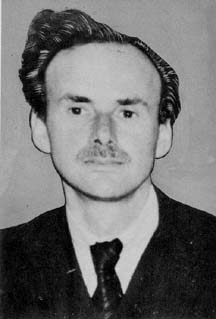Adapted from Eric's Treasure Trove.
Go to original
for links shown in blue.
 English physicist whose calculations predicted that particles should exist with negative energies. This led him to
suggest that the Electron had an "Antiparticle". This Antielectron was
discovered subsequently by Carl Anderson in 1932, and came to be called the
Positron. Dirac also developed a "spinor" version of the Schrödinger
Equation, known as the Dirac Equation, which is relativistically correct. For his work
on antiparticles and wave mechanics, he received the
Nobel Prize in physics in 1933.
English physicist whose calculations predicted that particles should exist with negative energies. This led him to
suggest that the Electron had an "Antiparticle". This Antielectron was
discovered subsequently by Carl Anderson in 1932, and came to be called the
Positron. Dirac also developed a "spinor" version of the Schrödinger
Equation, known as the Dirac Equation, which is relativistically correct. For his work
on antiparticles and wave mechanics, he received the
Nobel Prize in physics in 1933.
Additional biographies: MacTutor (St. Andrews), Bonn, and the
Nobel site.
References
Dirac, P. A. M. General Theory of Relativity. Princeton, NJ: Princeton University Press, 1996.
Dirac, P. A. M. History of Twentieth Century Physics.
Dirac, P. A. M. Quantum Mechanics, 4th ed. London: Oxford University Press, 1958.
Kragh, H. Dirac: A Scientific Biography. Cambridge, England: Cambridge University Press, 1990.
Kragh, H. ``Dirac.'' Sci. Amer., 104-109, May 1993.
Kursunoglu, B. and Wigner, E. P. (Eds.). Reminiscences about a Great Physicist: Paul Adrien Maurice Dirac.
Cambridge: Cambridge University Press, 1987.
© 1996-9 Eric W. Weisstein
1999-01-22
 English physicist whose calculations predicted that particles should exist with negative energies. This led him to
suggest that the Electron had an "Antiparticle". This Antielectron was
discovered subsequently by Carl Anderson in 1932, and came to be called the
Positron. Dirac also developed a "spinor" version of the Schrödinger
Equation, known as the Dirac Equation, which is relativistically correct. For his work
on antiparticles and wave mechanics, he received the
Nobel Prize in physics in 1933.
English physicist whose calculations predicted that particles should exist with negative energies. This led him to
suggest that the Electron had an "Antiparticle". This Antielectron was
discovered subsequently by Carl Anderson in 1932, and came to be called the
Positron. Dirac also developed a "spinor" version of the Schrödinger
Equation, known as the Dirac Equation, which is relativistically correct. For his work
on antiparticles and wave mechanics, he received the
Nobel Prize in physics in 1933.